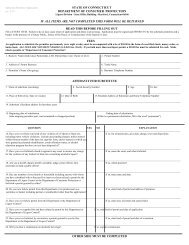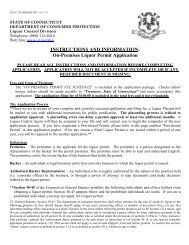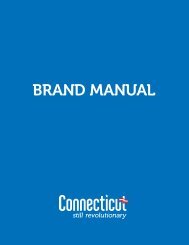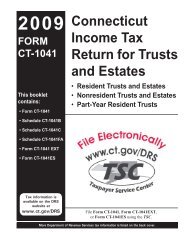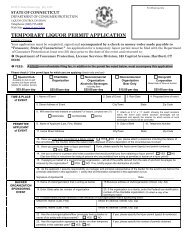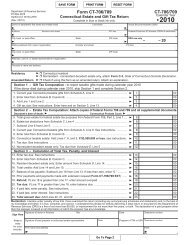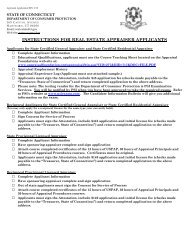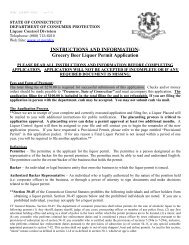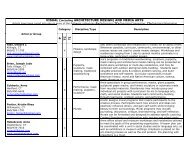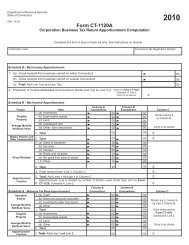CT-1120 Instructions, 2011 Connecticut corporation Business Tax ...
CT-1120 Instructions, 2011 Connecticut corporation Business Tax ...
CT-1120 Instructions, 2011 Connecticut corporation Business Tax ...
Create successful ePaper yourself
Turn your PDF publications into a flip-book with our unique Google optimized e-Paper software.
What’s New<br />
Direct Deposit Refund Option<br />
Beginning in the <strong>2011</strong> income year, a taxpayer may<br />
elect to have its refund amount directly deposited into<br />
a checking or savings account.<br />
Estimated <strong>Tax</strong>es<br />
Beginning with estimated tax payments for the 2012<br />
income year, a taxpayer that has filed its return on or<br />
before its due date or extended due date may apply an<br />
overpayment reported on such return against the first<br />
installment of estimated tax due for the succeeding<br />
income year.<br />
Conn. Gen. Stat. §12-242g, as amended by <strong>2011</strong><br />
Conn. Pub. Acts 61, §56.<br />
<strong>Tax</strong> Credit Limitation<br />
A taxpayer may use tax credits to offset more than<br />
70% of its tax due for income year <strong>2011</strong> and income<br />
year 2012 if the taxpayer has an average monthly<br />
net employment gain of greater than zero. Only<br />
employees who work at least 35 hours a week and<br />
who were not employed by a related person are taken<br />
into account in making this computation. The amount<br />
by which the taxpayer may exceed the 70% limitation<br />
is calculated on Form <strong>CT</strong>-<strong>1120</strong> TCE, <strong>Tax</strong> Credit Cap<br />
Expansion.<br />
Conn. Gen. Stat. §12-217zz, as amended by <strong>2011</strong><br />
Conn. Pub. Acts 6, §78.<br />
Foreign Corporations<br />
A foreign <strong>corporation</strong> that does not have U.S.<br />
effectively connected income (ECI) is exempted from<br />
the economic nexus provision. A foreign <strong>corporation</strong><br />
that has ECI shall have gross income for <strong>Connecticut</strong><br />
purposes equal to such ECI. Only property, payroll,<br />
and receipts that are effectively connected with a<br />
foreign <strong>corporation</strong>’s U.S. trade or business shall<br />
be used in calculating the foreign <strong>corporation</strong>’s<br />
<strong>Connecticut</strong> apportionment fraction.<br />
Conn. Gen. Stat. §12-216a, as amended by <strong>2011</strong><br />
Conn. Pub. Acts 61, §55.<br />
Job Expansion <strong>Tax</strong> Credit<br />
A new tax credit program has been established for<br />
taxpayers that hire new employees to fill new jobs<br />
after January 1, 2012 and before January 1, 2014.<br />
Page 4<br />
The amount of the tax credit is $500 per month for<br />
a new employee and $900 per month for a veteran<br />
employee or a qualifying employee. A new employee<br />
is a person who resides in <strong>Connecticut</strong> and is hired by a<br />
taxpayer to fill a new job. A veteran employee is a new<br />
employee who, at the time of hiring by the taxpayer,<br />
is a member of, was honorably discharge from or<br />
released under honorable conditions from active<br />
service in the armed forces. A qualifying employee<br />
is a new employee who, at the time of hiring by the<br />
taxpayer, is receiving unemployment compensation,<br />
has exhausted unemployment compensation without an<br />
intervening job, or is receiving vocational rehabilitative<br />
services from the Bureau of Rehabilitative Services.<br />
The employees must be hired to work full-time jobs<br />
or, for employees receiving vocational rehabilitative<br />
services, to work at least 20 hours per week for at least<br />
48 weeks per year.<br />
A business must apply to the Department of Economic<br />
and Community Development (DECD) for this tax<br />
credit and cannot claim any other tax credit with<br />
respect to the same employees. A taxpayer can claim<br />
this tax credit in the income year the credit is earned<br />
and the next two income years, but the tax credit<br />
cannot exceed the amount of tax due and does not<br />
carryforward. The tax credit can be claimed against<br />
the taxes imposed under Conn. Gen. Stat. chapters<br />
207, 208, 212, or 229 (other than Conn. Gen. Stat.<br />
§12-707).<br />
If a taxpayer has previously been issued an eligibility<br />
letter or certificate under the New Jobs Creation tax<br />
credit, the Qualified Small <strong>Business</strong> Job Creation tax<br />
credit, or the Vocational Rehabilitation Job Creation<br />
tax credit, then the provisions of those tax credits shall<br />
apply to the taxpayer for the duration of the eligibility<br />
letter or certificate.<br />
<strong>2011</strong> Conn. Pub. Acts 1 (Oct. Spec. Sess.), §19.<br />
Manufacturing Reinvestment Account<br />
Program<br />
A manufacturing reinvestment account (MRA)<br />
program has been established to allow manufacturers<br />
to set aside money to pay for certain qualifying<br />
expenses. For income years commencing on or<br />
after January 1, 2012, a manufacturer subject to the<br />
<strong>corporation</strong> business tax shall deduct from gross<br />
income any contribution to an MRA for the income<br />
year in which the contribution is made.




